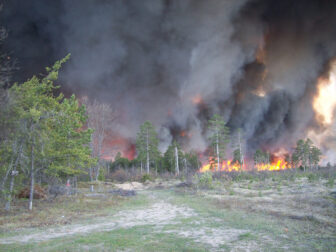
2010 wildfire in the Huron-Manistee National Forests. Image: USFWS Endangered Species, Wikimedia Commons
By Molly Wright
States across the Great Lakes region have allocated funds to local volunteer fire departments to fight wildfires and help meet the demand to expand fire protection.
The volunteer fire department is the dedicated first responder in many rural areas. These local departments play a crucial role in fire education and mitigation efforts.
There are over 26,000 rural and predominantly volunteer fire departments across the United States.
The Rural Fire Capacity program, also called Volunteer Fire Assistance, is awarded to states and funded equally by state and federal governments.
“The way it works is, each year the departments submit an application to the (Michigan) Department of Natural Resources (DNR) as to what projects they would like to secure funding for, and then the applications get reviewed and prioritized, and then the funds get distributed accordingly,” said State Fire Supervisor Dan Laux.
State natural resources agencies give the funds to fire departments in rural communities with populations under 10,000 to purchase equipment, training materials and other resources.
“The goal is to give the rural communities a boost in securing some much-needed equipment by providing them a funding mechanism to make purchases of items that
maybe they wouldn’t be able to make otherwise, and to help bolster their response capabilities,” said Laux.
The grants are designed to enable departments to create more fire-adapted communities and are not necessarily wildfire-specific.
“By allowing the fire department to purchase the equipment or gear, whatever it is that they find they have a need for, it goes towards supporting their suppression efforts. Not all of that is specific to wildland fire, but a good majority of it is,” said Laux.
“For example, a lot of the departments will purchase a slip-in tank unit which is basically a small pump, a small water tank, that they can put into the back of a pickup truck-size vehicle that allows them better access off-road,” said Laux.
The grants are part of the $2.4 billion awarded in 2021 by the U.S. Department of Agriculture for wildland fire management, a figure that has increased by $58.8 million from 2020.
According to state officials, Wisconsin has received $917,341.71 in assistance for 285 departments, including the maximum $10,000 for 18 of them. Pennsylvania has received $762,414 for 122 departments, 18 of which received the full $12,500.
Michigan has received $394,940 for 87 departments, though the exact amount each department got is unavailable, according to the Michigan DNR’s 2021 Wildland Fire Report.
For states, the funding comes amid an upward trend of concerning statistics about wildfires.
According to the National Interagency Fire Center, the peak wildfire season has been occurring earlier, shifting from August to July as of 2002.
“We noticed a little increase last season – it was probably a little busier of a season, but we are also noticing a little bit more of a longer length season,” said Laux.
Additionally, wildfires are burning longer and reaching further. In the last 18 years, 10 have broken records in terms of acreage burned.
Those trends coincide with many of the warmest years on record.
“It goes without saying that rain has been scarce this year for many parts of the state, as well as wider regions throughout the country,” Pennsylvania’ acting State Fire Commissioner Charles McGarvey said in an interview with Pennsylvania Environment Digest.
“Grant programs like these are essential financial pipelines that back their professional development and provide needed equipment and supplies so that firefighters can safely and successfully complete their missions,” said McGarvey.
